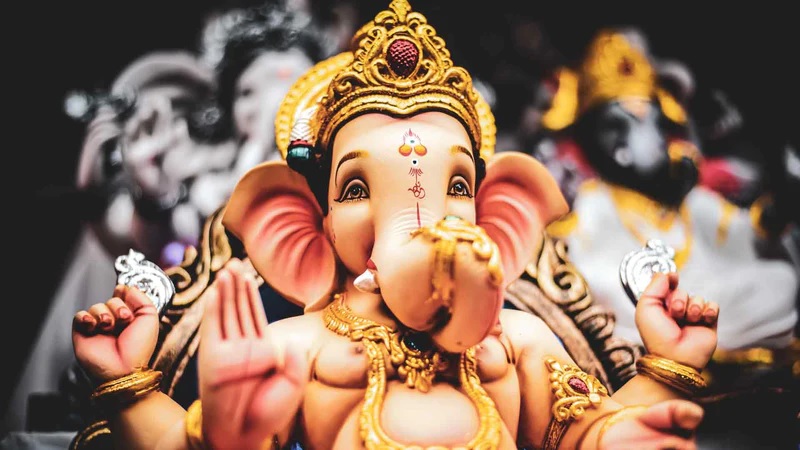


One day Goddess Parvati was at home on Mt.Kailash preparing for a bath. As she didn’t want to be disturbed, she told Nandi, her husband Shiva’s Bull, to guard the door and let no one pass. Nandi faithfully took his post, intending to carry out Parvati’s wishes. But, when Shiva came home and naturally wanted to come inside, Nandi had to let him pass, being loyal first to Shiva. Parvati was angry at this slight, but even more than this, at the fact that she had no one as loyal to Herself as Nandi was to Shiva. So, taking the turmeric paste (for bathing) from her body and breathing life into it, she created Ganesha, declaring him to be her own loyal son.
Shiva, having cooled down by this time, and realizing his mistake, agreed to Parvati’s conditions. He sent Brahma out with orders to bring back the head of the first creature he crosses that is laying with its head facing North. Brahma soon returned with the head of a strong and powerful elephant, which Shiva placed onto Ganesha’s body. Breathing new life into him, he declared Ganesha to be his own son as well and gave him the status of being foremost among the gods, and leader of all the ganas (classes of beings), Ganapati.
At first glance, this story just seems like a nice tale that we might tell our children or a myth without any real substance. But, it’s true mystical meaning is veiled. It is explained thus:
Parvati is a form of Devi, the Parashakti (Supreme Energy). In the human body, She resides in the Muladhara chakra as the Kundalini shakti. It is said that when we purify ourselves, ridding ourselves of the impurities that bind us, then the Lord automatically comes. This is why Shiva, the Supreme Lord, came unannounced as Parvati was bathing.
Nandi, Shiva’s bull, who Parvati first sent to guard the door represents the divine temperament. Nandi is so devoted to Shiva that his every thought is directed to Him, and he is able to easily recognize the Lord when He arrives. This shows that the attitude of the spiritual aspirant is what gains access to Devi’s (the kundalini shakti’s) abode. One must first develop this attitude of the devotee before hoping to become qualified for the highest treasure of spiritual attainment, which Devi alone grants.
After Nandi permitted Shiva to enter, Parvati took the turmeric paste from Her own body, and with it created Ganesha. Yellow is the colour associated with the Muladhara chakra, where the kundalini resides, and Ganesha is the deity who guards this chakra. Devi needed to create Ganesha, who represents the earthbound awareness, as a shield to protect the divine secret from unripe minds. It is when this awareness begins to turn away from things of the world, and toward the Divine, as Nandi had, that the great secret is revealed.
Shiva is the Lord and Supreme Teacher. Ganesha here represents the ego-bound Jiva. When the Lord comes, the Jiva, surrounded as it is with the murky cloud of ego, usually doesn’t recognize Him, and maybe even ends up arguing or fighting with Him! Therefore, it is the duty of the Lord, in the form of the Guru, to cut off the head of our ego! So powerful is this ego, however, that at first, the Guru’s instructions may not work, as Shiva’s armies failed to subdue Ganesha. It often requires a tougher approach, but, eventually the compassionate Guru, in His wisdom finds a way
Devi threatened to destroy the whole Creation after learning of Ganesha’s demise. This indicates that when the ego thus dies, the liberated Jiva loses interest in its temporary physical vehicle, the body, and begins to merge into the Supreme. The physical world is here represented by Devi. This impermanent and changeable creation is a form of Devi, to which this body belongs; the unchanging Absolute is Shiva, to which belongs the Soul. When the ego dies, the external world, which depends on the ego for its existence, disappears along with it. It is said that if we want to know the secrets of this world, which is a manifestation of Devi, then we must first receive the blessings of Ganesha.


Hinduism is a religion that is alive for thousands of years. It is such a tradition that was born in the Indian subcontinent and shaped the Indian culture. Hinduism is not only a religion but also an integral identity of the majority of Indians.
Read more